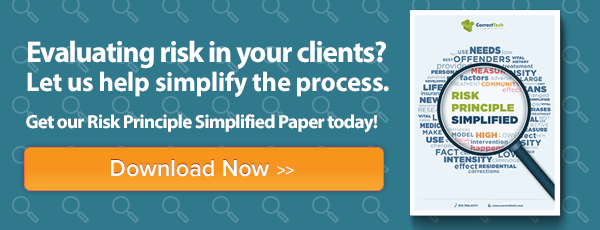This is the 1st of a 7 part series on The Risk Principle Simplified. Subscribe to our blog and get the series delivered right to your inbox.
The Risk Principle Simplified
Risk: The possibility of an adverse event.
“Risk” is a central theme in community corrections. In fact, I’ll bet that the first four concepts you learned when you entered the community corrections field were something like this:
- Assessment of criminogenic risk is vital
- An objective risk assessment should be utilized
- Intervention intensity should match risk level
- Over-treating low risk clients can make them worse
If you entered this field due to your desire to provide treatment to offenders, you may have grown tired of the emphasis on risk with this population. As a clinical psychologist who has dedicated his life to developing and implementing offender treatment programs, I understand your frustration. It can be difficult to focus on treatment in a corrections setting that emphasizes actuarial risk more than individual potential. However, risk is not just an academic concept, and the focus on risk is not ancillary to the treatment goals of community corrections. In fact, the purpose of community corrections revolves entirely around risk.
What is crimingenic risk?
"Criminogenic" literally means "crime creating". Criminogenic risk is a measurement of the probability that a specific offender will reoffend … if there is no intervention to lower risk. The second half of that definition is often ignored but is vital to the true meaning of the principle. Appropriate intervention can lower risk; in some cases, quite significantly. There are many misconceptions about "risk." Risk simply identifies the likelihood that an individual will commit another crime in the future. It does not speak to the severity or type of crime that may be committed. In other words, we are measuring the probability of an adverse event, not the nature of the adverse event.
The short-term goal of community corrections is risk containment. "Containment" is the action of keeping something harmful under control or within limits.
In our next blog in this series, we will address the "Why Does it Need to be Objective". Subscribe to our blog and get the series delivered right to your inbox.



